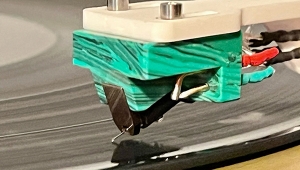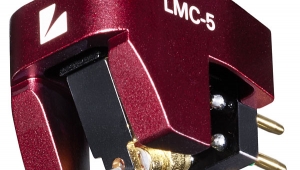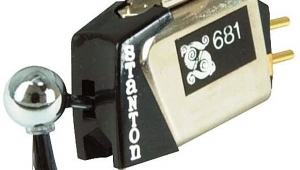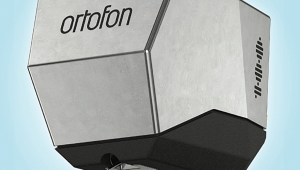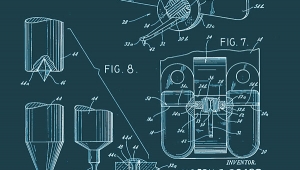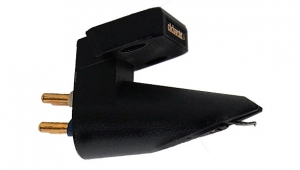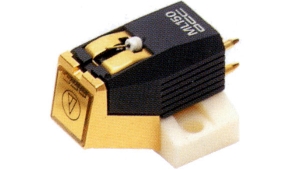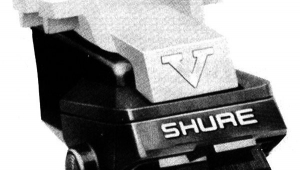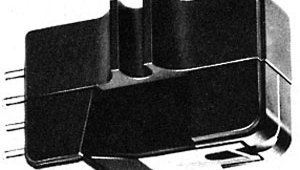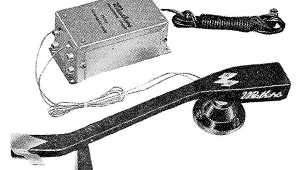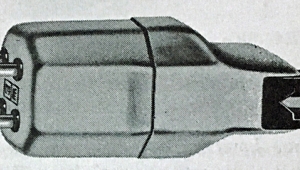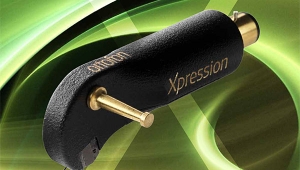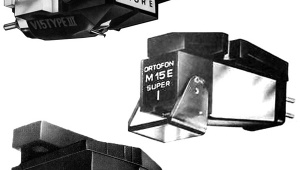| Columns Retired Columns & Blogs |
Dynavector DV10x5 MC phono cartridge Page 2
Given the above, you should know what it takes to use the DV10x5 in that setting. In particular, because the new Dyna is taller than the average phono cartridge—almost 19mm from the surface of the record it's sitting on to the top of its mounting platform (15mm is about average)—there's no escaping the fact that the owner of a Planar 3 absolutely must reposition the tonearm in order to raise it slightly, relative to the platter, to bring the stylus angle within spitting distance of the ideal.
Footnote 1: WAM Engineering, 247 Cherry Hill, Minneapolis, MN 55340. (612) 478-6685.
Luckily, this is easy to do: Remove the arm, place one or two standard Rega shims (available from your Rega dealer for $12 each) under its base, then replace and retighten the arm. I had fine results using a single shim under the arm base, in combination with a thinner-than-standard Linn felt mat. Before that, with the armtube too low, leading-edge transients were dull, musical timing suffered, stereo imaging was vague and lackluster. My theory is that, whether or not imaging is crucial to your enjoyment of recorded music, it's never a good idea to throw away something you've already bought and paid for.
All that said, it was interesting to note that the Dynavector DV10x5 is a physically perfect match for the Naim Aro tonearm, with its lack of provisions for adjusting overhang and tracking angle. From the cross centered at the Dyna's mounting holes to its stylus tip, the DV10x5 measures 9.4mm, which is exactly what a properly installed Aro requires for "automatically" correct alignment. Suddenly, the idea of a $360 cartridge on a $2500 tonearm doesn't seem quite so silly.
Electrically, the DV10x5 looks for any reasonable load over 1000 ohms—meaning that the 47k ohm load I had in mind, and that the cartridge would surely see in the vast majority of installations, was okay. For the record, the Dyna's own coil impedance is 150 ohms, which would indicate good (ie, efficient, non-bandwidth-compromised) transfer of power at highish preamp input impedances.
And the 2.5mV output? The MM boards on my vintage Naim preamp dealt with it handily, with most of my listening done with the volume knob at about 1 o'clock—this with a Naim 110 amplifier, Quad ESL-989s, and a listener who prefers moderate to loud levels.
One more setup observation: I had the best results tracking the Dynavector at 2.2gm, noted conditionally: ie, cartridge aligned carefully in accordance with a Rega-specific Wallytractor (footnote 1), broken in and played during mid-summer months at an elevation of approximately 1000' above sea level by a left-leaning reviewer. At lower forces than that, tracking ability suffered, especially audible on Wagnerian voices; at forces even slightly higher, the music sounded coarse, sluggish, and uninteresting.
Sing!
But dialed-in and broken-in, Dynavector's new cheapie was like a new Mini Cooper, or a John Deere L100 tractor, or almost every disc I've heard on the Naxos label: ridiculously good for the money.
On Cisco Records' superb reissue of the Milstein-Steinberg-Pittsburgh recording of the Dvork and Glazunov violin concertos (Capitol SP8382), the DV10x5 gave a clear, colorful, and reasonably well-scaled picture of the orchestra, with a large and very well-textured solo violin in front. Pitches were fine, there was faultless sense of musical flow—each of the many times I enjoyed this record with the Dyna, the experience was one of excitement rather than fatigue—and the PSO's famous ability to stop and turn on a dime was fairly portrayed. It was a "stop there" experience in almost every way: Yes, I suppose there are cartridges that make this record sound even more transparent, and maybe even more dramatic, but who can conceive of such a thing when listening to this? And for just $360?!
The DV10x5 was not a cartridge that required a steady diet of audiophile slop in order to earn its keep. There's more great tone than you'd expect in a lot of older Deutsche Grammophon LPs, for instance—the world-beating Beethoven Fifth by Carlos Kleiber (2530 516, available on reissue from Speakers Corner) being just one. The Dynavector found it, delivering rich, woody string sounds without compromising pitch accuracy or pacing.
More evidence of the Dyna's fine rhythmic qualities could be heard on Crosby, Stills & Nash, especially on Stephen Stills' "You Don't Have to Cry." (I have a standard Atlantic SD-8229 pressing and the Classic Records reissue, both good-sounding in their own ways, the latter boasting much quieter surfaces.) The Dyna was sufficiently free from lag, so the song moved forward easily (it doesn't always). The cartridge gave a clear enough temporal picture that it was easy to tell that the electric bass had been overdubbed after the bulk of the performance had already been recorded: The former keeps time; the guitars and voices that constitute the latter don't always.
I found it impossible to enjoy those acoustic guitars without wanting an even stronger dose of same—as on Rice & Blake, the first album recorded by bluegrass and old-time masters Tony Rice and Norman Blake (Rounder 0233). Tony's capoed guitar on the traditional "Little Beggarman" had just the right timbral fingerprint and perfect sonic texture; notes tumbled out with clear pitch and rhythmic shadings, and an almost startlingly realistic sense of the real human force of the picking behind them. That set the stage nicely for the next tune, "Shipyard Apprentice," on which Tony plays without capo—his instrument's consequently deeper bass showed off the DV10x5's rich, colorful, tight bottom end.
The fine Beethoven Egmont by George Szell and the Vienna Philharmonic (Decca SXL 6465, also on a Speakers Corner reissue and a fairly easy-to-find London LP) showed off the Dynavector's good poise under fire: It got louder without showing too much strain—the high-priced spread remains almost inevitably better, of course—and during the louder passages the sound slapped realistically off the walls, with what I consider the right amount of die-away. Imaging was fine, too—even the flutes, even under the great duress of the final bars of both the Egmont and the Siegessymphonie.
Footnote 1: WAM Engineering, 247 Cherry Hill, Minneapolis, MN 55340. (612) 478-6685.
- Log in or register to post comments
